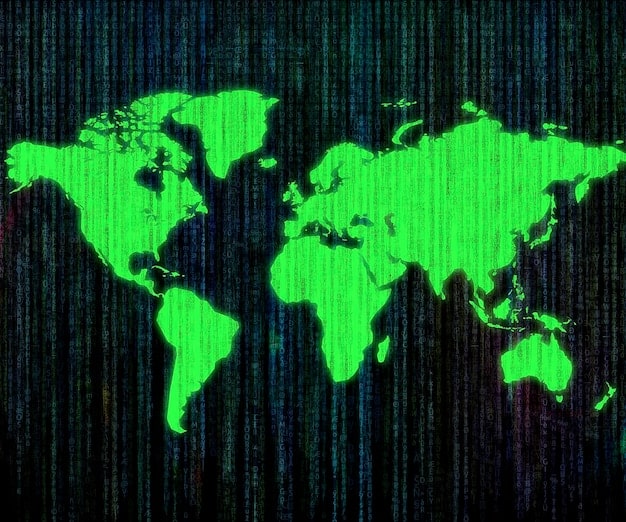NATO’s Future: Global Conflicts & US Role in 2025

The Future of NATO: How Global Conflicts are Reshaping the Alliance and US Role in 2025 involves adapting to new security challenges, including cyber warfare and climate change, while maintaining transatlantic unity amid evolving global power dynamics and the ongoing conflict in Ukraine, impacting US foreign policy and defense strategies.
The world is changing rapidly, and with it, the North Atlantic Treaty Organization (NATO) must adapt. Understanding The Future of NATO: How Global Conflicts are Reshaping the Alliance and US Role in 2025 is crucial for grasping the evolving geopolitical landscape and the United States’ role within it.
Understanding NATO’s Evolving Role
NATO, since its inception, has stood as a bulwark against threats to its member states. However, the nature of these threats is constantly evolving, requiring the alliance to adapt and redefine its role in global security.
Historical Context and Transformations
NATO was primarily formed to counter the Soviet Union’s influence during the Cold War. After the collapse of the Soviet Union, NATO had to redefine its purpose to remain relevant in the face of newer challenges.
The Core Mission of NATO
The core mission remains collective defense, as enshrined in Article 5 of the North Atlantic Treaty. An attack on one member is considered an attack on all, obligating all members to come to the defense of the attacked.

However, NATO’s mission has expanded to include crisis management, cooperative security, and projecting stability. These changes require a broader range of capabilities and strategies.
- Collective defense: Ensuring the security of member states against external threats.
- Crisis management: Responding to conflicts and humanitarian crises beyond member territories.
- Cooperative security: Partnering with non-member states to promote stability and shared security interests.
In conclusion, NATO’s role is continuously adapting to meet the needs of its members in an ever-changing global environment. Its importance in maintaining peace and security in the Euro-Atlantic area remains as critical as ever.
Current Global Conflicts and Their Impact on NATO
The rise of new global conflicts, particularly the war in Ukraine, presents unprecedented challenges to NATO. These conflicts are reshaping the alliance’s priorities and demanding a reassessment of its strategies.
The Ukraine Conflict: A Turning Point
The ongoing conflict in Ukraine has underscored the importance of NATO’s collective defense capabilities. It has also highlighted the limitations of the current security architecture.
Emerging Threats and Challenges
Beyond traditional military threats, NATO faces a range of emerging challenges, including cyber warfare, disinformation campaigns, and climate change. These require a multifaceted approach.
The alliance has adapted by:
- Increasing military presence in Eastern Europe, especially in the Baltic states and Poland.
- Enhancing cyber defense capabilities to counter state-sponsored attacks.
- Working with partner nations to address the security implications of climate change.
Overall, current global conflicts are forcing NATO to adapt more rapidly than ever before. The alliance is learning to balance traditional military readiness with the need to address new, non-conventional threats.
The US Role in NATO: Commitments and Challenges
The United States has historically been a leading force within NATO, providing substantial military and financial support. However, shifting domestic priorities and evolving geopolitical dynamics present challenges to US commitment.

US Contributions to NATO
The US contributes significantly to NATO’s budget, military capabilities, and strategic planning. Its commitment is seen as vital for maintaining the alliance’s credibility and effectiveness.
Balancing Domestic and International Priorities
The US faces the challenge of balancing its international commitments with domestic priorities, such as infrastructure development and healthcare. This balancing act often leads to debates about the appropriate level of US involvement in NATO.
Key aspects of balancing domestic and international commitments include:
- Maintaining a strong military presence in Europe while addressing domestic needs.
- Encouraging European allies to increase their defense spending to share the burden more equitably.
- Articulating a clear vision for NATO that resonates with both American and European audiences.
In conclusion, the US role in NATO remains critical, but it requires careful navigation of domestic and international pressures. The future of the alliance depends on the US maintaining its commitment while adapting to changing global dynamics.
NATO’s Strategic Priorities in 2025
Looking ahead to 2025, NATO must focus on several strategic priorities to remain effective in a complex security environment. These priorities include enhancing deterrence, strengthening partnerships, and addressing emerging threats.
Enhancing Deterrence Capabilities
NATO needs to enhance its deterrence capabilities to discourage potential adversaries from aggression. This involves maintaining a credible military presence and investing in advanced technologies.
Strengthening Partnerships with Like-Minded Nations
NATO should strengthen its partnerships with like-minded nations outside the Euro-Atlantic area to promote shared security interests. This includes countries in the Indo-Pacific region and beyond.
Key priorities for 2025 include:
- Increasing investment in defense technologies, such as artificial intelligence and cybersecurity.
- Conducting regular joint exercises with partner nations to enhance interoperability.
- Developing a comprehensive strategy to counter disinformation and hybrid threats.
Adapting to Emerging Technologies
NATO must incorporate emerging technologies, such as AI and quantum computing, to enhance its military capabilities and maintain a technological edge over potential adversaries.
In summary, NATO’s strategic priorities in 2025 revolve around enhancing deterrence, strengthening partnerships, and adapting to emerging threats. By focusing on these areas, the alliance can ensure its continued relevance and effectiveness.
The Impact of Technological Advancements on NATO
The rapid pace of technological advancement presents both opportunities and challenges for NATO. Harnessing new technologies while safeguarding against potential risks is essential for maintaining the alliance’s competitive edge.
Cyber Warfare: A Persistent Threat
Cyber warfare poses a persistent threat to NATO’s critical infrastructure and military operations. Protecting against cyber attacks requires a proactive and coordinated approach.
Artificial Intelligence and Autonomous Systems
Artificial intelligence and autonomous systems have the potential to revolutionize warfare. NATO must consider how to integrate these technologies responsibly and ethically.
Technological advancements require NATO to:
- Invest heavily in cybersecurity infrastructure to protect against attacks.
- Develop ethical guidelines for the use of AI in military operations.
- Promote collaboration between member states in the development and deployment of new technologies.
In conclusion, technological advancements are transforming the security landscape, requiring NATO to be agile and forward-thinking. By embracing new technologies responsibly, the alliance can enhance its capabilities and ensure its continued effectiveness.
Scenarios and Predictions for NATO in 2025
Forecasting the future is always challenging, but several scenarios can help inform NATO’s planning and decision-making. These scenarios range from continued stability to increased instability.
Scenario 1: Continued Geopolitical Stability
In this scenario, global conflicts remain contained, and NATO maintains a strong deterrent posture. The alliance focuses on enhancing its readiness and adapting to emerging threats.
Scenario 2: Increased Geopolitical Instability
In this scenario, new conflicts erupt, challenging NATO’s ability to respond effectively. The alliance must prioritize crisis management and rapid response capabilities. This may involve more frequent deployments and exercises.
Potential scenarios include:
- Increased tensions in the South China Sea requiring NATO to play a more active role in maritime security.
- Escalation of conflicts in the Middle East necessitating greater NATO involvement in stabilization efforts.
- Growing cyber attacks targeting critical infrastructure requiring NATO to develop enhanced cyber defense capabilities.
In summary, preparing for various scenarios is essential for ensuring NATO’s readiness and effectiveness. By anticipating potential challenges, the alliance can adapt and respond effectively to whatever the future may hold.
| Key Point | Brief Description |
|---|---|
| 🛡️ Collective Defense | Ensuring security of member states against threats. |
| 🌐 Crisis Management | Responding to conflicts beyond member territories. |
| 🤝 Partnerships | Collaborating with nations for shared security. |
| 💻 Cyber Defense | Protecting against evolving cyber threats and warfare. |
Frequently Asked Questions
▼
NATO’s primary goal is to safeguard the freedom and security of its member states through political and military means. This involves collective defense and crisis response.
▼
NATO addresses cyber threats by enhancing its cyber defense capabilities, promoting cyber hygiene, and collaborating with member states to share information and best practices.
▼
Article 5 of the North Atlantic Treaty stipulates that an attack on one member is considered an attack on all, obligating all members to come to the defense of the attacked country.
▼
The US is reshaping NATO by advocating for increased defense spending among European allies, focusing on emerging threats such as China, and promoting technological innovation within the alliance.
▼
Technology plays a crucial role in NATO’s future, enabling the alliance to enhance its military capabilities, counter cyber threats, and improve situational awareness through AI and autonomous systems.
Conclusion
In conclusion, the future of NATO hinges on its ability to adapt to evolving global conflicts and emerging threats, with the United States playing a critical role in guiding this transformation, ensuring the alliance remains a strong and relevant force for maintaining international peace and security in 2025 and beyond.





